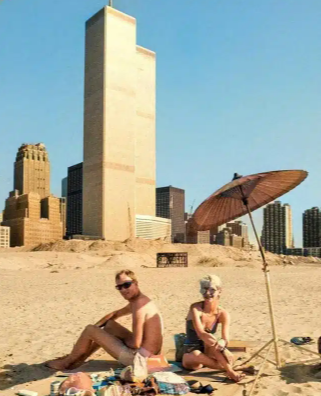
Discover the lost beach near the Twin Towers, a forgotten oasis where Manhattanites found solace before its transformation.
If you stroll near Battery Park today, it’s almost impossible to picture the sandy beach that once stretched along the waterfront where the Twin Towers stood. The area is now a hub of modern buildings, bustling streets, and serene promenades with views of the Statue of Liberty.
This urban shoreline once hosted a surprising sight: a beach where New Yorkers sunbathed and played. Beneath the shadow of the World Trade Center, this accidental oasis offered a peaceful escape from the city’s chaos, though its creation was never intentional.
The beach emerged in the mid-1970s due to construction delays during the building of the Twin Towers. Excavation from the project resulted in a sandy shoreline, which locals quickly embraced as a recreational haven. Volleyball games, quiet reading, and sunbathing became common pastimes under the looming towers.
Known as Battery Park Beach, this stretch of sand was more than an impromptu retreat. For Manhattanites like Suellen Epstein, who grew up nearby, it was a treasured getaway. Suellen recalled spending sunny Sundays there with her boyfriend, noting the rough texture of the sand and the rare solitude it offered in the bustling city.

For some, the beach symbolized more than leisure. In September 1979, it became the site of a monumental anti-nuclear rally. Thousands gathered on the sand, enjoying performances by Pete Seeger and Jackson Browne while Jane Fonda delivered a passionate speech. The event reignited a national protest movement, galvanized by the year’s nuclear accident in Harrisburg.
The beach also became a canvas for artistic expression. In the late 1970s and early 1980s, Creative Time funded public art projects there, including Mary Miss’s striking installations. Sculptor Nancy Rubins created a 45-foot tower of discarded objects, while Agnes Denes planted a wheatfield on two acres of sand, juxtaposing nature and urbanization.
Photos of these moments capture a poignant contrast: a serene, creative space shadowed by the World Trade Center. Artists like David Vanden-Eynden, who visited the beach in 1977, were captivated by its surreal charm and the unspoiled views of the towers.
By 1983, Battery Park Beach began to disappear as the area transformed into Battery Park City. Nearly all of the landfill was developed by 2000, erasing the accidental oasis. Then, in 2001, the events of September 11 reshaped the area and its history, casting a somber light on the carefree days captured in photos of the beach.
Looking back, these images evoke deep emotions. One observer remarked, “This picture contains it all: life, death, youth, age, stillness, anticipation.” They serve as a haunting reminder of how time reshapes the world and the memories we hold dear.
Today, the beach is gone, replaced by modern infrastructure and memorials. But its story endures as a testament to New York City’s ever-evolving spirit, a fleeting moment of peace and creativity amidst the chaos of life.


